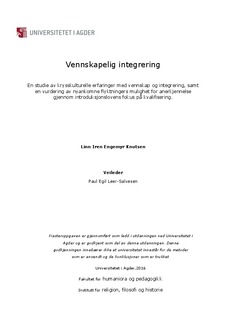| dc.description.abstract | This study is a qualitative study focusing on the experience refugee families and Norwegian families derived from a friendship family service during the period 1981 until today. The friendship family service was, and is, a service with the objective to create contact between newly arrived refugees and Norwegians. The study also contains ethical reflections linked to the term qualify and/or qualifying which is used in connection with The Introduction Act. The study therefore evaluates if The Introduction Act meet the newly arrived refugees with sufficient recognition based on Axel Honneths theory on recognition. The data consist of interviews with 22 people that all were engaged in the friendship-family service, and additionally interviews with two local community service leaders. Each of them leaders of their respective refugee work. In the study, I investigate if the friendship-families contributed to integrating the refugees, and parallel what participation as a friendship-family meant for the respective Norwegians. To help find the answers to my questions, I sought after the normative ideal that was the foundation upon which the friendship-family service was establishing, also seeking what results were expected as a consequence of the contact that was created. Integration was one of the objectives of the service, and therefore I investigated if the refugees experience, or view themselves as integrated in Norwegian society today. The service was based on relational contact that potentially could develop into friendship, and therefore it was natural to ask the participants if said contact still exists. Finally, I asked the interviewees them selves’ to categorize said contact.
This is an empirical focused study, and theories have been chosen with the purpose to illuminate the collected material. The collected material is analyzed in to main themes, integration and friendship. Common for the theoreticians is that they are relational-thinkers. Gordon W. Allports contact hypothesis (1954) presents the idea that contact over a period of time can reduce negative prejudice between people. He claims that friendship is the most effective way to achieve this. I use Allports thoughts especially to look at how the contact between the refugees and the Norwegian families has influenced the families’ children. Based on the terminology friendship I have chosen to utilize Aristotle, as his writing on friendship still today sets the philosophical agenda. Marcel Mauss and his book The Gift (1924) is included as theory under the analysis of friendship. This because friendship for Aristotle believes to prerequisites equality, freedom and symmetry, while gifts can often create dependency and asymmetry. The potential tensions between symmetry and asymmetry are of interest to analyze, and Mauss is therefore and important contributor. Axel Honneths theory of recognition (1992) came into being in a multi-cultural setting. It is formulated as a universal prerequisite for the development of an individual’s positive identity. Honneths theory is used as a guiding parameter in the ethical reflection linked to the use of the terms to qualify and/or qualifying. Arne John Vetlesen also writes about the individual’s freedom and recognition of different life choices. His writing contributes to illuminate whether The Introduction Programme gives refugees sufficient recognition.
My findings show that the normative ideal that formed the basis for establishing friendship-families in the 1980ies was linked to the humanitarian tradition. The objective was that Norwegian friendship-families should make the initial period for the newly arrived refugees easier. As time went on the hope was that the refugees might be integrated, and friendship between the refugees and the Norwegians might develop from the contact. The interviewees understand the term integration differently, but it seems, based on the empirical data, that integration has both a formal side and a relational side. With respect to the refugees own experience as integrated in Norwegian society, those that were adults on arrival, called the 1st generation, are integrated to a lesser degree than the 2nd generation. The 2nd generation speaks of itself as Norwegians, and speaks of other immigrants as foreigners. The refugee families all state that the Norwegian friendship-family was very important for their integration and feeling of belonging. The Norwegian families stress that participation in the friendship-family-service gave them new knowledge, and they experienced participating in something of importance. They feel they contributed to give recognition, and through this, they felt recognized. This underlines that recognition is symmetric. The children of the Norwegian friendship families express a natural openness towards immigrants and refugees due to their experience by participating in the service. All of the interviewed Norwegian friendship-families state that engaging in this activity was a valuable experience, and 21 out of 22 define the relationship as friendship. One relationship has lasted 35 years, another 20 years, while the majority of the remaining have today only occasional contact. Much of the reduced level of contact can be explained by natural causes, such as moving to a new location from where the relation started. In the last portion of the study, the ethical reflections link the qualifying term used in The Introduction Act to its opportunities to give the necessary recognition to the newly arrived refugees. This uncovers that qualifying cannot replace integration even if some would chose to do so. Integration consist of both a relational and formal part, where friendship-families support the relational, and qualifying the formal. These perspectives complementing each other, and are both important to create recognition and positive possibilities for newly arrived refugees. | nb_NO |

